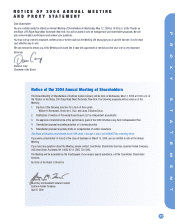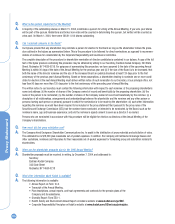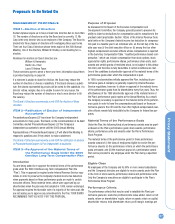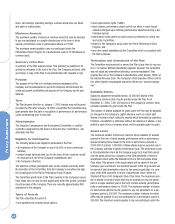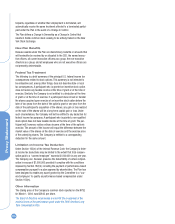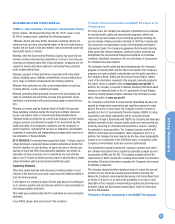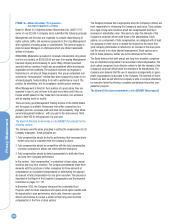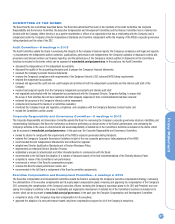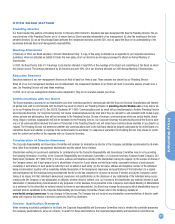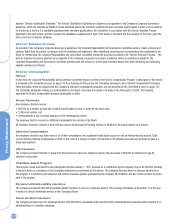Kodak 2003 Annual Report Download - page 91
Download and view the complete annual report
Please find page 91 of the 2003 Kodak annual report below. You can navigate through the pages in the report by either clicking on the pages listed below, or by using the keyword search tool below to find specific information within the annual report.
Proxy Statement
91
SHAREHOLDER PROPOSALS
ITEM 4—Shareholder Proposal—Chemicals Policy
Donna Colavito, 145 Bowers Road, Rock Hill, NY, 12775, owner of over
$2,000 in Company stock, submitted the following proposal:
“Whereas, dioxins and many similar chemicals containing chlorine are
extremely toxic, get more concentrated higher on the food chain (bioaccu-
mulate) and are found in food and mothers’ milk at levels that cause neg-
ative health effects in children;
Whereas, while the Environmental Protection Agency has found that any
emission of these extremely toxic pollutants is of concern, and many gov-
ernments are working toward their virtual elimination, companies are not
required to develop and report options for eliminating these pollutants
under existing federal laws;
Whereas, exposure to these pollutants is associated with many health
effects, including cancer, diabetes, endometriosis, immune dysfunctions
and a range of children’s developmental and learning problems;
Whereas, these pollutants are often created inadvertently, by reactions
involving chlorine, in many industrial processes;
Whereas, generating these pollutants is known to be unnecessary and
costly to companies and economies, because their generation can be
eliminated cost effectively with sound planning based on sound informa-
tion;
Whereas, processes used by Eastman Kodak at Kodak Park generate
these pollutants, including dioxins, the most toxic synthetic chemicals
known; and Kodak’s Vision of Environmental Responsibility affirms:
“Eastman Kodak is recognized as a world-class company, and the leading
imaging company, in protecting the quality of the environment and the
health and safety of its employees, customers, and the community in
which it operates;” indicating that we have an obligation to demonstrate
leadership in researching and implementing processes which result in vir-
tual elimination of these pollutants.
BE IT RESOLVED: The shareholders request that Kodak: 1) Adopt a plan for
virtual elimination of persistent bioaccumulative pollutants at Kodak Park
which A) identifies, for each building, all inputs and uses of chlorine, any
sources of dioxin and other bioaccumulative pollutants, and options for
elimination of these chemicals, and B) implements the most effective
option; and 2) Provide an annual summary report to shareholders on these
virtual elimination options and progress toward these goals.
Supporting Statement
This policy makes business sense because preventing pollution is cost
effective in the short term and avoids costly long-term liabilities related to
toxic chemical exposures.
It will improve our company’s image if Kodak goes beyond its existing pol-
icy to minimize pollution and joins the new efforts for virtual elimination of
toxic bioaccumulative pollutants.
This builds upon existing Kodak efforts to implement non-toxic production
strategies.
If you AGREE, please mark your proxy for this resolution.”
The Board of Directors recommends a vote AGAINST this proposal for the
following reasons:
For many years, the Company has designed, implemented and conducted
far reaching health, safety and environmental programs, which have
reduced the use and release of toxic chemicals generally, including the
use and release of bioaccumulative materials. In 1998 the Company pub-
licly announced a comprehensive series of environmental performance
improvement goals. The Company’s aggressive efforts toward achieving
these goals have reduced emissions, conserved natural resources and
strengthened the environmental management systems at its facilities
worldwide. Significant reductions in the use and release of bioaccumula-
tive materials have been realized.
The Company’s health, safety and environmental goals, the Company’s
progress in achieving them and the nature and results of the Company’s
programs are made available to shareholders and the public generally in
the Company’s Health, Safety and Environment Annual Report. Indeed,
much of the information requested in the proposal is already included in
this report, which is available online at www.kodak.com/go/HSE.In
addition, the Company is required to disclose extensive information about
emissions of chemicals listed on the U.S. government’s Toxics Release
Inventory, including bioaccumulative materials. This information is avail-
able to the public at www.epa.gov/tri.
The Company’s commitment to environmental stewardship has been rec-
ognized by independent organizations and regulatory agencies in many
parts of the world. In recent years, the Company received a number of
awards from the U.S. Environmental Protection Agency (USEPA) for reduc-
ing pollution and energy consumption and for conserving natural
resources. Through a partnership with USEPA, the Company has developed
pollution prevention tools to improve public health and environmental pro-
tection by screening for chemicals with properties of concern, including
the potential for bioaccumulation. The Company has since worked with
USEPA to make these tools available to other companies in the U.S. In
addition, the Company has been selected by the Dow Jones Sustainability
Indexes to be a component of the DJSI World Index, in recognition of the
Company’s environmental, social and economic performance.
This shareholder proposal requests the Company to provide more exten-
sive, detailed information than is required by generally accepted account-
ing principles (GAAP) and the SEC. The Company complies with all the
requirements of GAAP and the SEC, including those related to environmen-
tal matters. All material information regarding the Company’s environmen-
tal liabilities is disclosed.
The Company already has taken significant action to reduce the use and
emission of toxic chemicals including bioaccumulative materials. We
believe the Company’s environmental disclosures in its Annual Report and
on Forms 10-K and 10-Q, as well as the availability of an easy-to-read
description of the Company’s environmental programs and performance in
its Health, Safety and Environment Annual Report, meet the information
needs of shareholders.
The Board of Directors recommends a vote AGAINST this proposal.


